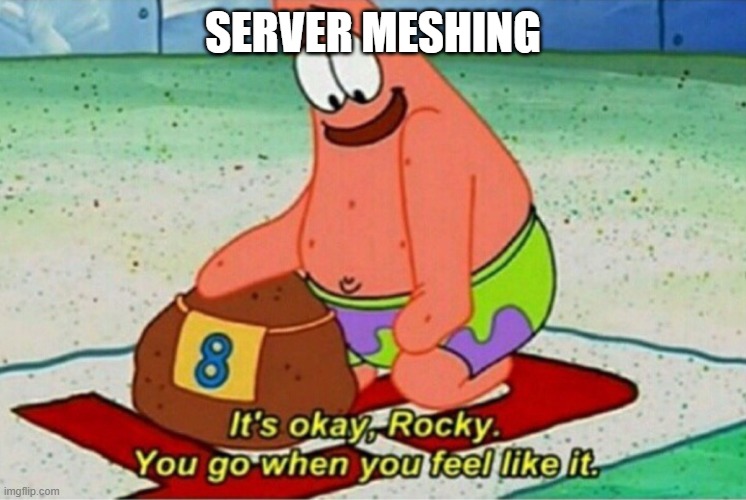Traffic mgt, security, and observability. Looking at the possibilities CIG is having meshing problems is beyond me. For one, we are paying premium for AWS and for CIG to blame meshing is beyond me, with their failed architecture. CIG is small potatoes compared to many more of Amazons customers.
So, why have we been discussing “meshing for the last 2-3 years” … I forget how many years. Every time I play and spend two hours mining I get a disconnect. Every time someone brings up the Server/network meshing bullshit. We all know it is easy to throw the problem over the fence for non-technical customers. I’m calling out CIG as bullshit… either they have a horrible infrastructure, or they are lying to us flat out.
I do not know how fucked up the CIG PU is but it sounds pretty fucked up if they have not been able to fix the meshing issue yet. Please do not tell me another 5 years for meshing, because I am at my last thread.
That is my thesis… so, lets look at this. Please see my links below.
Conclusion, as I said in my thesis, CIG does not seem to be seriously addressing the meshing problem because if they were, it would not be a 3 year problem, but a 3 month problem.

 www.redhat.com
www.redhat.com
… way to control how different parts of an application share data with one another.
Each part of an app, called a “service,” relies on other services to give users what they want.
This new service will communicate with a database of product tags to make recommendations, but it also needs to communicate with the same inventory database that the product page needed—it’s a lot of reusable, moving parts.
But what if some services get overloaded with requests, like the retailer’s inventory database? This is where a service mesh comes in—it routes requests from one service to the next, optimizing how all the moving parts work together.
Amazon meshing
https://docs.aws.amazon.com/app-mesh/latest/userguide/meshes.html
Matter of clicks
A service mesh is a logical boundary for network traffic between the services that reside within it. After you create your service mesh, you can create virtual services, virtual nodes, virtual routers, and routes to distribute traffic between the applications in your mesh.
https://docs.aws.amazon.com/app-mesh/latest/userguide/what-is-app-mesh.html
Elastic
https://www.elastic.co/guide/en/cloud-on-k8s/current/k8s-service-mesh-istio.html
Istio
https://istio.io/latest/docs/concepts/what-is-istio/
Istio makes it easy to create a network of deployed services with load balancing, service-to-service authentication, monitoring, and more, with few or no code changes in service code. You add Istio support to services by deploying a special sidecar proxy throughout your environment that intercepts all network communication between microservices, then configure and manage Istio using its control plane functionality
Amazon Database

Databases
https://aws.amazon.com/rds/
So, why have we been discussing “meshing for the last 2-3 years” … I forget how many years. Every time I play and spend two hours mining I get a disconnect. Every time someone brings up the Server/network meshing bullshit. We all know it is easy to throw the problem over the fence for non-technical customers. I’m calling out CIG as bullshit… either they have a horrible infrastructure, or they are lying to us flat out.
I do not know how fucked up the CIG PU is but it sounds pretty fucked up if they have not been able to fix the meshing issue yet. Please do not tell me another 5 years for meshing, because I am at my last thread.
That is my thesis… so, lets look at this. Please see my links below.
- Amazon is not a lightweight… they have tech for everything, from meshing to databases plus much more.
- Service meshing is a click away.
- Microservices vs meshing… microservice is old school and things have changed.
- Cloud services by definition – instances grow and contract by demand from spinning up new servers to memory to storage.
- Seems like a relational vs no-sql database issue. Elastic is the standard for no-sql and I do not understand why their issues are so bad. If they are using Microsoft sql sever, they are throwing money away every day.
- Ask yourself what the banking industry uses…
- We have already spent 5 years correcting the problems from 10 years ago, game in Alpha (10 fricken years) … If this were a real business, it would have failed 7 years ago. I am more convinced that CIG is riding the gravy train, and every year that passes CIG falls into the vaporware category.
- Every year that passes that this game is in Alpha, the legal argument gets stronger for future legal action.
- Making an effort is not the same as producing.
Conclusion, as I said in my thesis, CIG does not seem to be seriously addressing the meshing problem because if they were, it would not be a 3 year problem, but a 3 month problem.

What is a service mesh?
Read this article to find out more about what a service mesh is, how it works, and the benefits and challenges of implementing a service mesh.
… way to control how different parts of an application share data with one another.
Each part of an app, called a “service,” relies on other services to give users what they want.
This new service will communicate with a database of product tags to make recommendations, but it also needs to communicate with the same inventory database that the product page needed—it’s a lot of reusable, moving parts.
But what if some services get overloaded with requests, like the retailer’s inventory database? This is where a service mesh comes in—it routes requests from one service to the next, optimizing how all the moving parts work together.
Amazon meshing
https://docs.aws.amazon.com/app-mesh/latest/userguide/meshes.html
Matter of clicks
A service mesh is a logical boundary for network traffic between the services that reside within it. After you create your service mesh, you can create virtual services, virtual nodes, virtual routers, and routes to distribute traffic between the applications in your mesh.
https://docs.aws.amazon.com/app-mesh/latest/userguide/what-is-app-mesh.html
Elastic
https://www.elastic.co/guide/en/cloud-on-k8s/current/k8s-service-mesh-istio.html
Istio
https://istio.io/latest/docs/concepts/what-is-istio/
Istio makes it easy to create a network of deployed services with load balancing, service-to-service authentication, monitoring, and more, with few or no code changes in service code. You add Istio support to services by deploying a special sidecar proxy throughout your environment that intercepts all network communication between microservices, then configure and manage Istio using its control plane functionality
Amazon Database
Databases
https://aws.amazon.com/rds/
Last edited:


